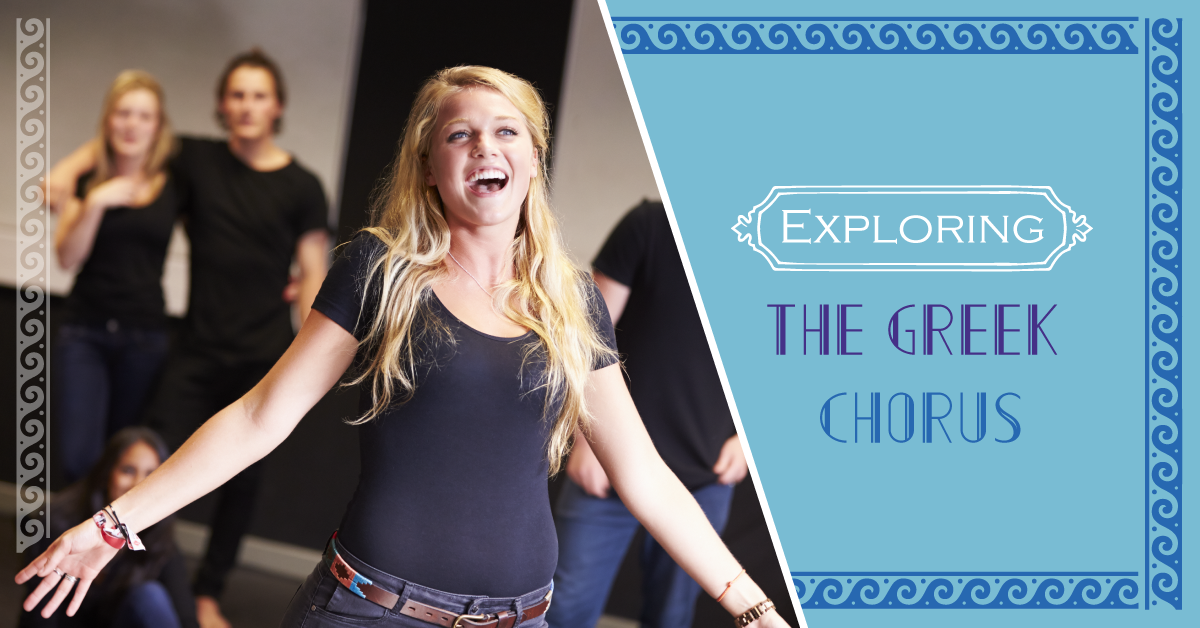Exploring the Greek Chorus
In Ancient Greek Theatre, there is an interesting similarity among the plays written during that time: there is always a chorus included. Nowadays most people would associate a chorus with musicals, but playwrights like Aeschylus, Euripides, and Sophocles included a chorus in their regular plays. The chorus consisted of a group of 12 to 50 players who spoke or sang their lines in unison, wore masks, and functioned as one actor rather than a large group of many performers.
The purpose of the Greek chorus was to provide background and summary information to the audience to help them understand what was going on in the performance. They commented on themes, expressed what the main characters couldn’t say (like secrets, thoughts, and fears) and provided other characters with information and insights.
Because Greek theatres were so large, the members of the chorus had to work hard to look and sound like one person. Their diction and lines had to be presented crisply and clearly so the entire audience could easily hear them. Their gestures were overly exaggerated. Frequently a chorus leader, called a coryphaeus, would aid with comprehension.
Here’s an excerpt of a speech performed by the chorus in The Trojan Women by Euripides:
In Salamis, filled with the foaming of
billows and murmur of bees,
Old Telamon stayed from his roaming,
Long ago, on a throne of the seas;
Looking out on the hills olive-laden,
Enchanted, where first from the earth
The grey-gleaming fruit of the Maiden
Athena had birth; A soft grey crown for a
city Belovèd, a City of Light: Yet he
rested not there, nor had pity, But went
forth in his might, Where Heracles
wandered, the lonely Bow-bearer, and lent
him his hands
For the wrecking of one land only, Of Ilion,
Ilion only, most hated of lands!
It continues on for three more sections but even this small sample illustrates the challenge of the lines. It shows how focused and precise the Greek chorus had to be to be able to speak these lines in unison and to be clearly understood by the audience!
How can you apply this to the classroom?
Here’s an exercise to try in the drama classroom which will help students to understand and explore the Greek chorus. Divide students up into groups (try for groups of at least 5-6, even though traditionally the smallest chorus was 12 people). Give each group a mundane, everyday activity like:
- Brushing their teeth
- Packing a lunch
- Choosing an outfit to wear
- Walking to school
- Feeding the dog
Have the students work together to write and present a Greek chorus piece that narrates the actions of the mundane activity. They must write at least six full sentences in modern language or a more poetic style. Whatever style they choose, encourage them to be extremely detailed and descriptive. Here’s an example, using the teeth-brushing suggestion:
Morning time, and Sarah awakes!
She opens her eyes and rubs out
the sleep of a dreamless night.
Slowly, slowly she rises from her bed
and stumbles to yonder bathroom.
Reaching deliberately towards the toothbrush
That promises clean teeth that resemble white pearls.
Toothpaste, with claims of minty freshness
Is spread upon the bristles in haphazard fashion.
One by one, cleansing foam envelops each tooth.
A rinse of clear, cool water
and Sarah is nearly ready to face the day.
Fun, right? Once the chorus is written, one student will act as protagonist (first actor) and perform the actions that the rest of the students (as the chorus) will narrate, using exaggerated actions. The chorus will recite the piece they created, working on speaking clearly and with great diction, to illustrate what the protagonist is doing. Have the groups present their performances in front of the rest of the class.
To take the performance a step further, students could create masks or simple costumes to go along with their presentations. For example, in the tooth-brushing scenario, the protagonist might wear pajamas and a sleep mask on their head, and the chorus might dress up as tooth fairies with wings and tiaras. Or perhaps make toga-like outfits out of comforters or colourful bedsheets. Get creative!



